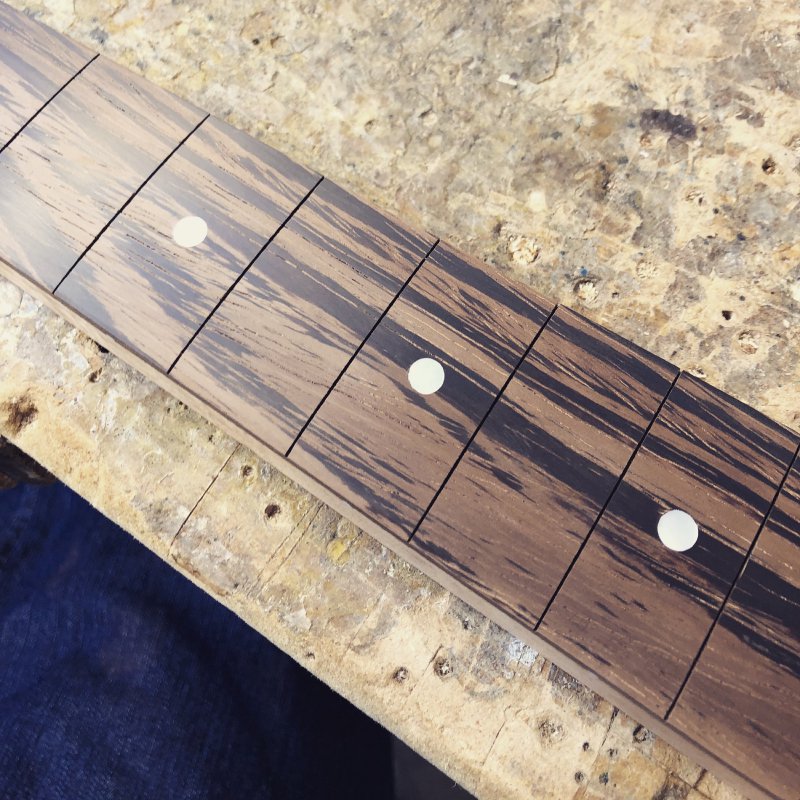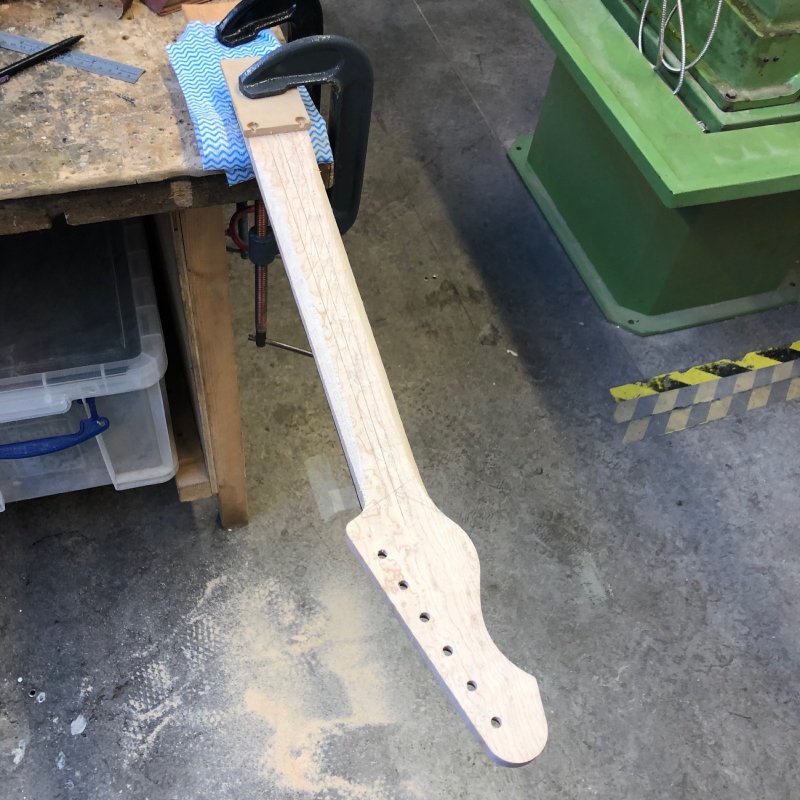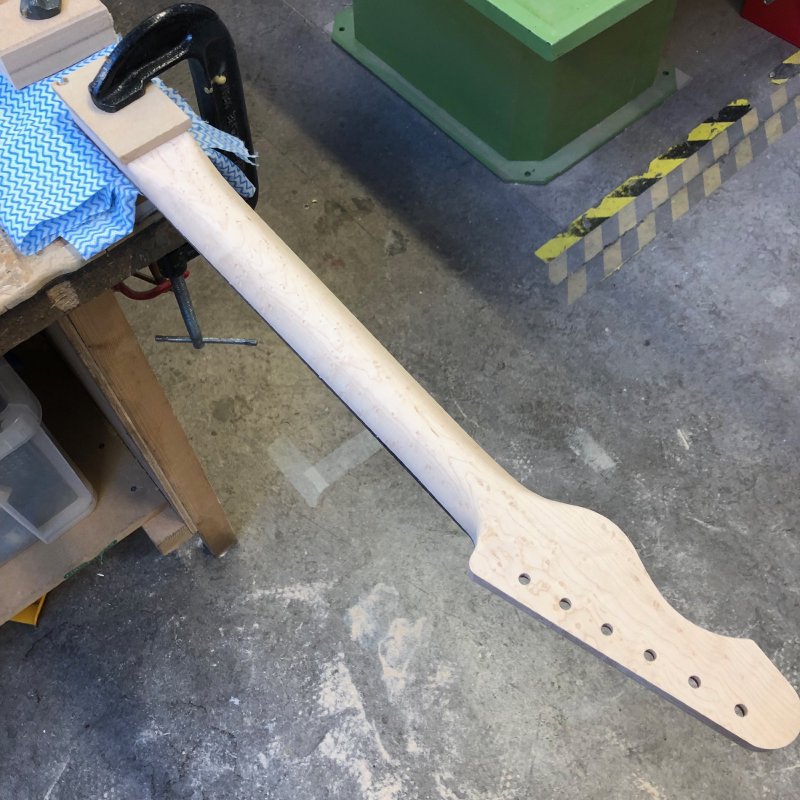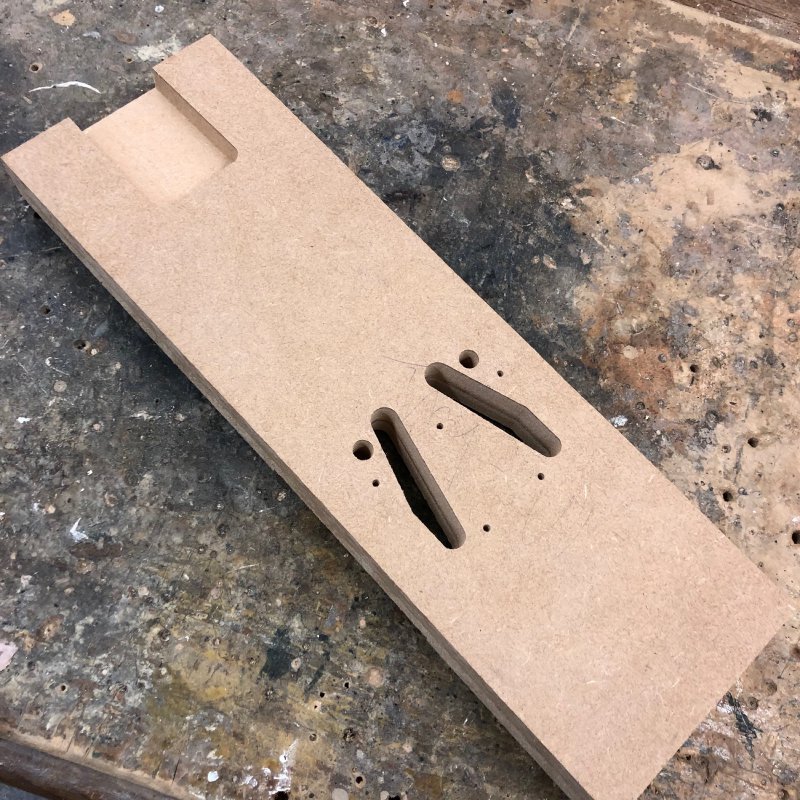A week (mostly not) in the shop
Published 21 Oct 2018
My run of having to do contract work that keeps me out the shop for the majority of the week continues, as I happen to have a couple of clients both with near term deadlines, but I managed to safeguard a day and a half this week to be in the shop and move things forward on The Clydesdale (the commissioned offset). To start with I finished getting the fretboard just right. and sanding smooth the transition between the headstock and the fretboard. Wenge is a particularly tough wood to work with I find, so getting the finish right on the radius and removing all the machine tool marks from first facing it off and then adding the rough radius took quite a bit of elbow grease, but the results are worth it:

The frontside done, then it was onto the rear of the neck to carve the bulk of the neck, which I do by hand using a Shinto hand rasp. I don’t just go at it blind, I set up a bunch of pencil guidelines to help me get the initial facets from which I then just freehand, taking frequent pauses to check how it feels when you make various chord shapes and using a straight edge to check the taper is right.

This is the firs time I’ve made a neck with birds eye maple, and the back has come up wonderfully textured as you can see.

The neck is now roughly sanded smooth and I’m happy with the feel, so the next step is to get the frets in.
My new audio recording gear arrived this week. I’ve been shooting little demo videos with my iPhone, but the audio quality isn’t that great through its microphone (the microphone is fine, just it’s not pointed at the amp where the sound is coming from :). Whilst in general I’m quite content writing this blog over making videos, there are times with musical instruments when a short video with sound will capture something much more succinctly than I could do so in prose, so I’ve been trying to solve the audio quality issue. My desired solution was to mic up my amp properly, and get a thing that I could plug straight into my phone so I could record things straight to instagram or youtube without any additional steps: to this end I ordered a Sennheiser e609 microphone and a Zoom U-22 portable audio interface.

The Sennheiser microphone appealed to me because of its low physical profile and it has a good reputation (along with the higher end version the e906). Where my amp is set up I don’t have the free space required for a regularly shaped microphone on a mic-stand, so the arrangement with the e609 draped over the amp as in the picture above is perfect, as I can leave it in place all the time without having to worry about getting it all setup when inspiration to record something strikes. The U22 is a simple microphone pre-amp that’ll take in a standard microphone XLR connection and output it to USB audio, and is supported to work with iOS devices through Apple’s USB/Lighting adapter (not all USB audio devices will work this way, particularly if they need power over USB). Thus I just need to plug the U-22 into my iPhone before firing up the camera app and everything Just Works™.
Here’s a little video I recorded this week to test it all works:
For the most part it did just work, but there is one small snag in that it seems if you give iOS mono input it treats this as stereo audio with just the left channel when it’s recording video. I did some hunting around for solutions to this, and it seems a general problem with some of Apple’s video tools when presented with mono input. Unfortunately I’ve not yet found a neat way to solve this. For the above video I had to import the final movie into the old Quicktime Pro 7 tool, then export the audio as a mono track and import that back into iMovie where it did the correct thing. Whilst this works, it’s no good for quick off the cuff record and post to web scenarios I hoped for. If you have a better solution please let me know, or I’ll post one here when I find it.
I’m also interested to note the Zoom U-22 claims to take guitar direct in, which means in theory I could use it as a replacement for my IK Multimedia iRig 2 adapter that I cart around with me when I know I won’t have an amp to practice with. I’ll report back on how that goes when I get time to try it.
As mentioned a while back, I have this finished offset guitar where I’m not yet happy with the dynamic vibrato bridge setup, and I’ve not had time to investigate it. The first step to understanding why the dynamic vibrato isn’t happy is understanding the mechanics of how it works at all, and to that end I wanted to build an experimental jig where I can attach the bridge unit but see what’s going on inside. To this end, I knocked up this jig whilst feeling a bit too tired to work on fine detail work like neck carving:

The bridge cavities you can see in the centre go all the way through to the back and are the same depth as the cavities on the actual guitar, just open on the back. I’ll attach some clear perspex to this and then I’ll be able to see how the bridge works, whilst at the same time checking it’s not rubbing on the sides or the bottom. I also have a bunch of springs of different tension I can try, and this jig lets me change those and see how good they are without risk of scratching the actual guitar. Some fun experiments ahead, which I’ll try to record, as there’s very little info out there that I can find on setting up this type of vibrato system. I did chat to an owner of some vintage mustangs this week and he says both his stay in tune fine, so I know it’s an achievable aim.
Finally, a bit of dull but important admin: I’ve started implementing better backups for my laptop. Whilst I do back up my Mac laptop using Apple’s Time Capsule device, that device is starting to creak at the seams a bit, and at the same time backups are becoming all the more vital for me. When I wrote software I’d push everything to a cloud server designed to store software code, but for a lot of the guitar work I do there is no nice easy service, so more of value resides on my local disk. Also, doing more rich media content like videos means I need more reliable storage than I can fit in my laptop too.
The solution to this has been I’ve got a Synology NAS storage system, to which I’m going to be both backing up my laptop, and using it as a holding place for large video and audio files that I generate. The NAS has three drives in it, one of which is just used to double check on the other two (it’s a RAID array if you’re technically minded), so not only does it mean I have things off my laptop which can get lost/destoryed etc., but the NAS itself is tolerant of a disk failing too.
Anyway, this is mostly tedious admin, but let this be a reminder if you don’t have backups for your work then you should do. I’ve had several hard disks die on me over the years, and backups are vital to getting back to business quickly when such things happen.